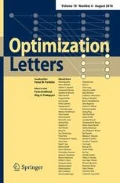Abstract
In this work, a model for legal financiers’ strategies is presented, taking into account that the aim of a bank is to minimize the default probability of the funded company, constrained with reaching a certain profit level. To obtain our purpose, a stochastic dynamics optimization model is constructed and solved in closed form and a Monte Carlo simulation involving empirical data is also implemented. The financial strategies are thus obtained.
Similar content being viewed by others
References
Altman E.I.: Financial ratios, discriminant analysis and the prediction of corporate bankruptcy. J. Finance 68(4), 589–611 (1968)
Altman E.I.: Measuring corporate bond mortality and performance. J. Finance 44(4), 909–922 (1989)
Altman E.I., Caouette J.B., Narayan P.: Managing Credit Risk. The Next Great Financial Challenge. Wiley Frontiers in Finance, New York (1998)
Altman E.I., Haldeman R.G., Narayan P.: ZETA analysis: a new model to identify bankruptcy risk of corporations. J. Bank. Finance 1, 29–54 (1977)
Altman E.I., Sabato G.: Effects of the new basel capital accord on bank capital requirements for SMEs. J. Financ. Serv. Res. 28, 15–42 (2005)
Altman E.I., Saunders A.: Credit risk measurement: developments over the last 20 years. J. Bank. Finance 21, 1721–1742 (1998)
Anderson R., Sundaresan S.: A comparative study of structural models of corporate bond yields: an exploratory investigation. J. Bank. Finance 24, 255–269 (2000)
Baesens B., Gestel T.V., Viaene S., Stepanova M., Suykens J., Vanthienen J.: Benchmarking state-of-the art classification algorithms for credit scoring. J. Oper. Res. Soc. 54, 627–635 (2003)
Baourakis G., Conisescu M., Van Dijk G., Pardalos P.M., Zopounidis C.: A multicriteria approach for rating the credit risk of financial institutions. Comput. Manag. Sci. 6, 347–356 (2009)
Barone, R., Cerqueti, R., Quaranta, A.G.: Illegal financier and usurer behavior. Eur. J. Law Econ. (2011, in press)
Borkar V.S.: Optimal Control of Diffusion Processes. Pitman Research Notes in Mathematics Series. Longman Scientific & Technical, Harlow (1989)
Brennan M., Schwartz E.: Corporate income taxes, valuation, and the problem of optimal capital structure. J. Bus. 51, 103–114 (1978)
Caballero R.J., Pindyck R.S.: Uncertainty, investment, and industry evolution. Int. Econ. Rev. 37, 641–662 (1996)
Carrara D., Cavalli E.: Bankruptcy Prediction. In: Bertocchi, M., Cavalli, E., Komlosi, S. (eds) Modelling Techniques for Financial Markets and Bank Management, Springer, Heidelberg (1996)
Cifarelli M.D., Masciandaro D., Peccati L., Salsa S., Tagliani A.: Success or failure of a firm under different financing policies: a dynamic stochastic model. Eur. J. Oper. Res. 136(3), 471–482 (2002)
Dixit A.: Hysteresis, import penetration, and exchange-rate pass-through. Q. J. Econ. 104, 205–228 (1989)
Duan J.C.: Maximum likelihood estimation using price data of the derivative contracts. Math. Finance 4, 155–167 (1994)
Duan, J.C., Gautier, G., Simonato, S., Zaanouns, S.: Estimating Merton’s model by maximum likelihood with survivorship consideration. In: European Financial Association Conference—Maastricht Meeting Papers no. 4190 (2004)
Fleming W.H., Soner H.M.: Controlled Markov Processes and Viscosity Solutions. Applications of Mathematics (New York). Springer, New York (1993)
Gilbert L., Menon K., Schwartz K.: Predicting bankruptcy for firm in financial distress. J. Bus. Finance Account. 17, 161 (1990)
Gordy M.B.: A comparative anatomy of credit risk models. J. Bank. Finance 24(1–2), 119–149 (2000)
Gordy M.B.: A risk-factor model foundation for ratings-based bank capital ratios. J. Financ. Intermediation 12, 199–232 (2003)
Krouse C.G., Lee W.Y.: Optimal equity financing of the corporation. J. Financ. Quant. Anal. 8, 539–563 (1973)
Krylov N.V.: Controlled Diffusion Processes. Springer, New York (1980)
Leahy, J.: The optimality of myopic behavior in a competitive model of entry and exit. Discussion Paper No. 1566, Harvard University, August 1991
Leland H.: Corporate debt value, bond covenants, and optimal capital structure. J. Finance 49(4), 1213–1252 (1994)
Leland H., Toft K.B.: Optimal capital structure, endogenous bankruptcy, and the term structure of credit spreads. J. Finance 51(3), 987–1019 (1996)
Li, Y., MacLean, L.C., Ziemba, W.T.: Security and wealth aspects of optimal capital growth models with minimum expected time criteria. Mimeo, University of British Columbia (1996)
Longstaff F., Schwartz E.: A simple approach to valuing risky debt. J. Finance 50, 789–821 (1995)
Masciandaro D.: In offense of usury laws: microfoundations of illegal credit contracts. Eur. J. Law Econ. 12(3), 193–215 (2001)
Masciandaro, D., Peccati, L., Tagliani, A.: Why Usury Can Be Cheaper? pp. 453–468. Atti del XXI Convegno A.M.A.S.E.S, Rome (1997)
Modigliani F., Miller M.: The cost of capital corporation finance, and the theory of investment. Am. Econ. Rev. 48, 261–277 (1958)
Merton R.C.: On the pricing of corporate debt: the risk structure of interest rates. J. Finance 29, 449–470 (1974)
Øksendal B.: Stochastic Differential Equations. An Introduction with Applications, 4th edn. Universitext, Springer, Berlin (1995)
Pardalos, P.M., Tsitsiringos, V. (eds): Financial Engineering, E-commerce and Supply Chain (Applied Optimization). Kluwer, Dordrecht (2002)
Sethi S.P.: Optimal equity financing model of Krouse and Lee: corrections and extensions. J. Financ. Quant. Anal. 13(3), 487–505 (1978)
Sethi S.P., Taksar M.I.: Optimal financing of a corporation subject to random returns. Math. Finance 12(2), 155–172 (2002)
Yong J., Zhou X.Y.: Stochastic Controls. Hamiltonian Systems and HJB Equations. Applications of Mathematics. Springer, New York (1999)
Author information
Authors and Affiliations
Corresponding author
Rights and permissions
About this article
Cite this article
Cerqueti, R., Quaranta, A.G. The perspective of a bank in granting credits: an optimization model. Optim Lett 6, 867–882 (2012). https://doi.org/10.1007/s11590-011-0310-6
Received:
Accepted:
Published:
Issue Date:
DOI: https://doi.org/10.1007/s11590-011-0310-6




